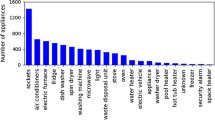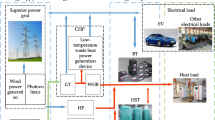Abstract
The California Independent System Operator (CAISO) has implemented Convergence Bidding (CB) on February 1, 2011 under Federal Energy Regulatory Commission’s September 21, 2006 Market Redesign and Technology Upgrade Order. CB is a financial mechanism that allows market participants, including electricity suppliers, consumers and virtual traders, to arbitrage price differences between the day-ahead (DA) market and the real-time (RT) market without physically consuming or producing energy. In this paper, market efficiency is defined in terms of trading profitability, where a zero-profit competitive equilibrium implies market efficiency (Jensen in, J Financial Econ 6(2):95–101, 1978). We analyze market data in the CAISO electric power markets, and empirically test for market efficiency by assessing the performance of trading strategies from the perspective of virtual traders. By viewing DA–RT spreads as payoffs from a basket of correlated assets, we can formulate a chance constrained portfolio selection problem, where the chance constraint takes two different forms as a value-at-risk constraint and a conditional value-at-risk constraint, to find the optimal trading strategy. A hidden Markov model (HMM) is further proposed to capture the presence of the time-varying forward premium. This is meant to be a contribution to the modeling of regime shifts in the electricity forward premium with unobservable states. Our backtesting results cast doubt on the efficiency of the CAISO electric power markets, as the trading strategy generates consistent profits after the introduction of CB, even in the presence of transaction costs. Nevertheless, by comparing with the performance before the introduction of CB, we find that the profitability decreases significantly, which enables us to identify the efficiency gain brought about by CB. Convincing evidence for the improvement of market efficiency in the presence of CB is further provided by the test for the Bessembinder and Lemmon (J Finance 57(3):1347–1382, 2002) model.













Similar content being viewed by others
Notes
http://www.caiso.com/market/Pages/MarketProcesses.aspx. Accessed January 26th, 2015.
http://www.caiso.com/2429/24291016c12990. Accessed January 26th, 2015.
\(x_t^{(j)}\) is the \(j\)-th entry of \(x_t\).
http://www.caiso.com/2429/24291016c12990. Accessed January 26th, 2015.
See Appendix for details.
The day-ahead spot market or the spot market in Europe is similar to the DA market in the United States, where the delivery of electricity for each of the 24 hours is settled one day in advance.
The CalPX was founded in 1998. It declared bankruptcy and permanently ceased market operations during 2000–2001 California energy crisis. During its existence, the CALPX administered market transactions, while the CAISO ensured the reliable management of transmission network.
We use upper case letters to denote random variables, and lower case letters to denote realizations of random variables.
The majority of Pacific Gas and Electric Company’s load is located in NP15.
Stars indicate 5 % significance levels.
Summary statistics for pre-CB DA–RT spreads are reported in Table 12 .
A full covariance matrix is estimated in this study, but only diagonal elements are presented in Table 6 to convey insights.
We assume the risk-free interest rate is 3% in the calculation of excess return.
The upper bound of the estimated costs allocated to 1 MWh of cleared virtual position is used to ensure the robustness of our results.
Generally, low, medium, and high trading frequencies are defined as position holding periods of months, days, and hours, respectively.
This is consistent with Jha and Wolak (2013) that after the implementation of CB the implied trading costs decrease but the difference between the implied trading costs before and after the implementation of CB is relatively small at the NP15 trading hub for all three hypothesis tests.
CAISO List of Scheduling Coordinators (SCs), Congestion Revenue Rights (CRR) Holders, CB Entities as updated on July 8th, 2014. http://www.caiso.com/Documents/ISOListofSCsCRRsCBEs_July_2014pdf. Accessed July 23rd, 2014.
To follow the convention in the finance literature, we use the term “speculators” referring to informed traders who explore price deviations and stabilize prices. The term “speculators” and “traders” are interchangeable in our paper.
Informational setup costs is the implicit costs of collecting and analyzing market information.
\(\alpha \) is nonnegative, since \(\alpha = \left( \frac{1}{\eta } E\left[ \left( R_t^T y_t+ \gamma \right) ^2\right] \right) ^{\frac{1}{2}} \ge 0\).
References
Anderson, R. W., & Danthine, J.-P. (1983). Hedger diversity in futures markets. Economic Journal, 93, 370–389.
Backus, D. K., Foresi, S., & Telmer, C. I. (2001). Affine term structure models and the forward premium anomaly. Journal of Finance, 56(1), 279–304.
Baillie, R. T., & Kilic, R. (2006). Do asymmetric and nonlinear adjustments explain the forward premium anomaly? Journal of International Money and Finance, 25(1), 22–47.
Baron, D. P. (1982). A model of the demand for investment banking advising and distribution services for new issues. Journal of Finance, 37(4), 955–976.
Bekaert, G., & Hodrick, R. J. (1993). On biases in the measurement of foreign exchange risk premiums. Journal of International Money and Finance, 12(2), 115–138.
Benth, F. E., Cartea, Á., & Kiesel, R. (2008). Pricing forward contracts in power markets by the certainty equivalence principle: Explaining the sign of the market risk premium. Journal of Banking & Finance, 32(10), 2006–2021.
Bessembinder, H., & Lemmon, M. L. (2002). Equilibrium pricing and optimal hedging in electricity forward markets. Journal of Finance, 57(3), 1347–1382.
Bilmes, J. A., et al. (1998). A gentle tutorial of the em algorithm and its application to parameter estimation for gaussian mixture and hidden markov models. International Computer Science Institute, 4(510), 126.
Cartea, Á., & Villaplana, Pablo. (2008). Spot price modeling and the valuation of electricity forward contracts: The role of demand and capacity. Journal of Banking & Finance, 32(12), 2502–2519.
De Jong, C. (2006). The nature of power spikes: A regime-switch approach. Studies in Nonlinear Dynamics & Econometrics, 10(3), 1361.
De Meza, D., & Webb, D. C. (1987). Too much investment: a problem of asymmetric information. Quarterly Journal of Economics, 102(2), 281–292.
Deng, S. (2000). Stochastic models of energy commodity prices and their applications: Mean-reversion with jumps and spikes. Berkeley: University of California Energy Institute.
Duffie, D., & Pan, J. (1997). An overview of value at risk. Journal of Derivatives, 4(3), 7–49.
Fama, E. F. (1970). Efficient capital markets: A review of theory and empirical work*. Journal of Finance, 25(2), 383–417.
Fama, E. F. (1984). Forward and spot exchange rates. Journal of Monetary Economics, 14(3), 319–338.
Fama, E. F., & French, K. R. (1987). Commodity futures prices: Some evidence on forecast power, premiums, and the theory of storage. Journal of Business, 60(1), 55–73.
Ghahramani, Z. (2001). An introduction to hidden markov models and bayesian networks. International Journal of Pattern Recognition and Artificial Intelligence, 15(01), 9–42.
Ghahramani, Z., & Jordan, M. I. (1997). Factorial hidden markov models. Machine Learning, 29(2–3), 245–273.
Haldrup, N., & Ørregaard Nielsen, M. (2006). A regime switching long memory model for electricity prices. Journal of Econometrics, 135(1), 349–376.
Hansen, L. P., & Hodrick, R. J. (1980). Forward exchange rates as optimal predictors of future spot rates: An econometric analysis. Journal of Political Economy, 88(5), 829–853.
Hirshleifer, D. (1990). Hedging pressure and futures price movements in a general equilibrium model. Econometrica, 58, 411–428.
Huisman, R., & Mahieu, R. (2003). Regime jumps in electricity prices. Energy Economics, 25(5), 425–434.
Janczura, J., & Weron, R. (2010). An empirical comparison of alternate regime-switching models for electricity spot prices. Energy Economics, 32(5), 1059–1073.
Jensen, M. C. (1978). Some anomalous evidence regarding market efficiency. Journal of Financial Economics, 6(2), 95–101.
Jha, A., & Wolak, F. A. (2013). Testing for market efficiency with transactions costs: An application to convergence bidding in wholesale electricity markets. Technical report, Working Paper.
Keynes, J. M. (1923). Some aspects of commodity markets. Manchester Guardian Commercial: European Reconstruction Series, 13, 784–786.
Longstaff, F. A., & Wang, A. W. (2004). Electricity forward prices: A high-frequency empirical analysis. Journal of Finance, 59(4), 1877–1900.
Lucia, J. J., & Schwartz, E. S. (2002). Electricity prices and power derivatives: Evidence from the nordic power exchange. Review of Derivatives Research, 5(1), 5–50.
Miller, E. M. (1977). Risk, uncertainty, and divergence of opinion. Journal of Finance, 32(4), 1151–1168.
Modigliani, F., & Modigliani, L. (1997). Risk-adjusted performance. Journal of Portfolio Management, 23(2), 45–54.
Mount, T. D., Ning, Y., & Cai, X. (2006). Predicting price spikes in electricity markets using a regime-switching model with time-varying parameters. Energy Economics, 28(1), 62–80.
Nemirovski, A., & Shapiro, A. (2006). Convex approximations of chance constrained programs. SIAM Journal on Optimization, 17(4), 969–996.
Rockafellar, R. T., & Uryasev, S. (2000). Optimization of conditional value-at-risk. Journal of Risk, 2, 21–42.
Rolfo, J. (1980). Optimal hedging under price and quantity uncertainty: The case of a cocoa producer. Journal of Political Economy, 88(1), 100–116.
Samuelson, P. A. (1965). Proof that properly anticipated prices fluctuate randomly. Industrial Management Review, 6(2), 41–49.
Shawky, H. A., Marathe, A., & Barrett, C. L. (2003). A first look at the empirical relation between spot and futures electricity prices in the united states. Journal of Futures Markets, 23(10), 931–955.
Weron, R. (2009). Heavy-tails, regime-switching in electricity prices. Mathematical Methods of Operations Research, 69(3), 457–473.
Author information
Authors and Affiliations
Corresponding author
Appendices
Appendix 1
With \(\phi (u) = (u+1)_+^2\), we can show \(\phi (\frac{u}{\alpha }) \ge {I} (u \ge 0) \) for any \(\alpha >0\). By substituting \(u=- R_t^T y_t -\gamma \), we have \( \phi ( \frac{1}{\alpha }(- R_t^T y_t -\gamma ) ) \ge {I}( - R_t^T y_t -\gamma \ge 0)\). Taking expectation on both sides yields,
By multiplying \(\alpha \) on both sides and replacing the positive part function, we can further show a conservative approximation of \( P( - R_t^T y_t -\gamma \ge 0) \le 1-\eta \) in the following form,
Rearranging \(\alpha E[ ( \frac{1}{\alpha }(- R_t^T y_t -\gamma ) + 1 )^2 ] \le \alpha (1-\eta ) \) yields,
Noticing that (42) is a quadratic function, we can minimize the function by setting \(\alpha = \left( \frac{1}{\eta } E\left[ \left( R_t^T y_t+ \gamma \right) ^2\right] \right) ^{\frac{1}{2}}\).Footnote 21 By substituting \(\alpha = \left( \frac{1}{\eta } E\left[ (R_t^T y_t+ \gamma )^2\right] \right) ^{\frac{1}{2}}\) into (42), we derived the Chebyshev bound,
Appendix 2
See Tables 12, 13, 14, 15, 16, 17 and 18.
Appendix 3
Rights and permissions
About this article
Cite this article
Li, R., Svoboda, A.J. & Oren, S.S. Efficiency impact of convergence bidding in the california electricity market. J Regul Econ 48, 245–284 (2015). https://doi.org/10.1007/s11149-015-9281-3
Published:
Issue Date:
DOI: https://doi.org/10.1007/s11149-015-9281-3
Keywords
- Convergence bidding
- Market efficiency
- Trading strategy
- Value-at-risk
- Conditional value-at-risk
- Hidden Markov model








